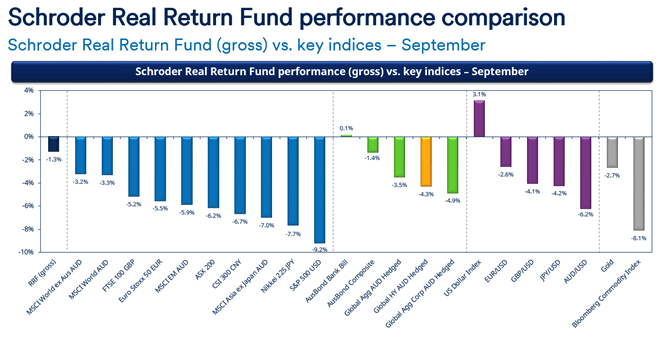Stubbornly high inflation puts pressure on markets
The key driver of September’s broad-based and significant weakness was inflation, and the realignment of interest rates to the reality of stubbornly higher inflation, dashing hopes that central banks would respond to market weakness and signal a more dovish rate outlook. However, there are signs of system stress, which may lead to a moderation in the aggressive pace of tightening being pursued.
The broad-based sell-off in bond and equity markets regained momentum in September. The numbers make grim reading, with the S&P 500’s -9.3% decline taking its decline this year to -23.9%, and the sell-off in US government bonds delivering a return on US 10-year treasuries of -4.7% (-15.7% year-to-date). Against this, the USD remains strong, rising +3.1% in September in trade-weighted terms (or 16.8% year-to-date).
Commodities (GSCI) declined -8.7% in the month, led by oil, but reflecting generally softer prices across the board as global demand weakened. While the weakness in equities is significant, it’s not out of the ‘norm’. For bonds though, the bear market has now wiped out the cumulative returns from the last 10 years from 10-year government bonds, the worst performance since the 1950s.
The Schroder Real Return Fund returned -1.3% (pre-fees) with our extreme defensive positioning including our lowest equity weighting since inception (amid the GFC) mitigating the impact, but unable to fully insulate returns from the breadth and depth of September’s asset price weakness. That said, some context is needed, and the chart below provides this – showing the Strategy’s performance against the major asset classes. The chart shows it outperformed all but cash and US dollars in this line-up.

The key driver of September’s weakness was inflation, and the realignment of interest rates to the reality of stubbornly higher inflation dashed hopes that Central Banks would respond to market weakness and signal a more dovish rate outlook, perhaps even halting tightening altogether. While it is unlikely Central Banks will reverse course, emerging signs of system stress suggest that the pace of tightening may moderate.
(Mostly) orderly unravelling
Despite the breadth and extent of falls so far, the unravelling of markets has been relatively orderly. The key exception to this though has been the UK. The British pound (GBP) was battered, with the UK Gilt market collapsing after the UK government unveiled a budget with significant unfunded tax cuts (fiscal stimulus). At the same time, the Bank of England (BOE) is tightening policy to battle rampant cost of living pressure in the economy. With currency and money markets rioting, the BOE had little choice but to intervene to halt the risk to the UK financial system and the spillover into the global economy.
This highlights the fragility of the global financial system in this environment, and that there are clearly pain points that will force Central Banks to intervene.
However, we do not read this as a signal that other central banks (like the US Federal Reserve or the European Central Bank) are poised to reverse course on monetary tightening, albeit a moderation in the pace of tightening is probable. If anything, it highlights the need that policy settings to be aligned with economic realities for long-run financial stability.
Data in September provided clear evidence of this reality. US inflation continued to surprise on the upside, with US headline inflation of 8.3% y/y. More concerning, core CPI rose to 6.3% y/y, confirming that inflation is not just an oil story but indeed becoming more broad-based. To put this into perspective, the trimmed mean inflation rate (which strips out the largest increases/decreases) rose to a new high of 7.2% – well above the 5.1% reached at the peak of the 80-90s. This places even more pressure on the Fed to continue a hawkish policy stance, despite signs of continuing economic weakness and rising recession risk.
Our recession dashboard now has 60% of its components flashing red. Excluding the GFC Recession of 08-09, this is the highest reading in over three decades. This places risk assets in a precarious situation as central banks around the world are forced into a corner of continuing to tighten policy into a slowdown. Liquidity is also likely to be under pressure in the coming months as US quantitative tightening steps up to US$95bn per month, almost double the maximum US$50bn per month seen in the 2018 liquidity crisis.
Valuations are improving
While recession fears and liquidity tightening remain key negatives for risk assets, the positive is that valuations are improving in response to price weakness. For example, the US S&P 500 is trading on a forward PE of around 15x, which is not out of line with historical market bottoms given the level of inflation and interest rates being priced by the market. However, this does assume that earnings can continue to deliver going forward, which we think is unlikely. Earnings revisions have turned negative, and margins appear to be rolling over. We believe further weakness in company margins (reflecting higher input costs including wages and weaker demand) will lead to more aggressive earnings downgrades over the coming months.
While this might not become evident until the September or December earnings quarter, shock downgrades like the recent announcement from FedEx may accelerate this process in the coming months.
We believe a ratcheting down of earnings in the face of tighter monetary policy settings will lead to the next move lower in equity markets. While caution is required, we expect markets to remain volatile, which does present opportunities to modify our positioning. While our overall equity weight remains low, we did add 5% to our exposure in the last week of September, as we believe that in the medium-term context, current levels present a reasonable point to start cautiously re-investing.
Bonds remain volatile
Fuelled by dislocation in the UK and stubbornly high inflation, September proved another extremely volatile month for government bonds. 10-year bond yields in Australia pushed briefly above 4% and close to 4% in the US before easing back towards month end, helped by BOE intervention in the Gilt market. While we do expect more tightening (and ongoing hawkishness), the pace of tightening (size of increases and the time between them) will likely moderate from here, as central banks start to assess the impact of the accumulated rise to date on growth and inflation, and emerging signs of system distress. While markets sometimes forget, central bankers are acutely aware of the lags between rate rises and their impact (albeit this doesn’t mean they won’t still over-tighten as their track record isn’t great).
Any duration has been a drag on total returns this year and we clearly started to add duration too early this year. That said, we did lean into the weakness of late September, buying predominately longer-dated bonds in the US and Australia. This was done to take advantage of higher yields on offer and the likelihood that market focus will switch towards recession risk from inflation risk in coming months, shifting the balance of risk to lower yields. We think it likely that if the next phase of equity weakness is driven by earnings (and recession) then the bonds are likely to be a more effective hedge than they have been so far this year.
Outlook
We are acutely aware that markets will likely turn well before the uncertainty around economic outcomes clears. As we have noted above, we have been looking to lean into market weakness and are starting to re-invest cash at higher yields, wider spreads, and improved equity valuations, all of which provide an improved base for future returns. The caveat is that current volatility is not reflecting a mid-cycle correction where ‘buy-the-dip’ is the right strategy. We are in the midst of a more classic business cycle. The pro-cyclical policy has led to overheating, asset price inflation, and the need to tighten. The extent of the over-stimulus and its reflection in inflation means recession is a likely outworking of policy tightening. This will take time to play out and there will be casualties that are yet unknown (albeit we are starting to see more signs of stress – like the UK and potentially the odd investment bank). Markets will be volatile for a while yet, so while we are seeking to prudently deploy cash, we remain inherently cautious. An earnings recession could well mean another 10-20% decline in equity prices – that’s the real buying opportunity for exceptional medium-term returns.
Take advantage of opportunities wherever they exist
With the flexibility to invest across a broad range of asset classes, we aim to help investors grow their wealth with a reduced risk of losing money when markets fall. Click 'contact' to find out more, and make sure you keep up to date with our latest Livewire content by hitting 'follow' below.
2 topics
1 fund mentioned

